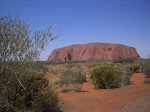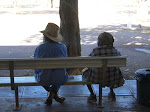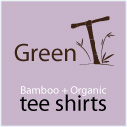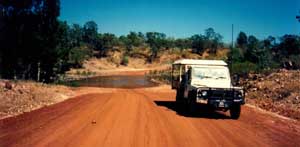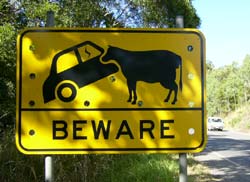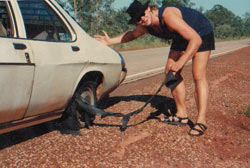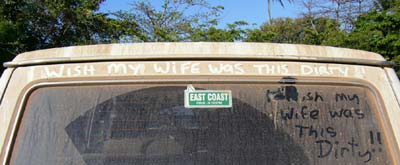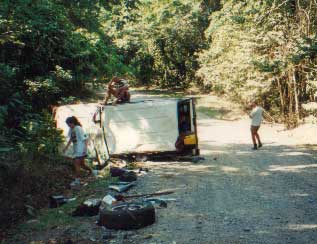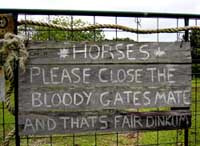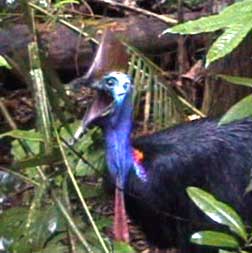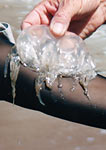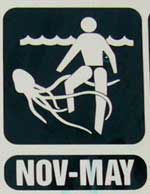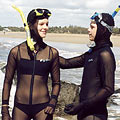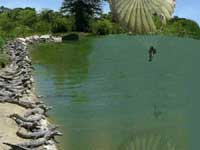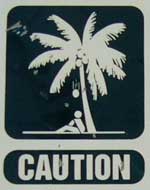Geography and Climate
- Australia is the driest inhabited continent on earth, only Antartica is drier. About 35% of the continent is desert.
- Australia is the smallest continent on earth or the largest island on earth.
- Australia is the sixth largest nation (7,692,000 square kms), by land area, after Russia, Canada, China, USA, and Brazil and is the only one of the top six completely surrounded by water.
- Australia is approximately 32 times the size of the UK and equally as large as the USA excluding Alaska.
- Australia's coastline is approx. 59,700km in length including islands. Mainland Australia's coastline measures 33,500km in length.
- Australia is approx. 3,700 kms long (north to south - including Tasmania) and 4,000kms wide (east to west).
- Mt Kosciuszko in the state of New South Wales is the highest mountain in Australia at 2,228 metres (7,305 feet).
- Lake Eyre in South Australia is the largest lake in Australia and is Australia's lowest point at 15 metres below sea level.
- Australia is the flatest continent on earth.
- The Nullarbor Plain extends for 2,000km across the southern parts of South Australia and Western Australia and includes the longest section of straight railway track in the world (478km) and the longest straight section of tarred highway in the world (146.6km).
- Uluru, formerly named Ayers Rock, is a monolithic sandstone rock that rises 345 metres above the surrounding plain and covers an area of 3.3 square kilometres. It is thought Uluru goes several kilometres deep below the surface.
- The longest river in Australia is the Murray/Darling River at 3,370km.
- The Great Barrier Reef off the coast of the state of Queensland is the largest coral reef in the world - more than 2,300km long, and can be seen from space.
- Fraser Island, located just off the south coast of Queensland is the largest sand island in the world.
- The highest temperature ever recorded was 53 degrees celsius (127 fahrenheit) at Cloncurry in the state of Queensland in 1889.
- Marble Bar in Western Australia is the holder of the longest heatwave record in the world when temperatures of more than 37.8 degrees celcius (100 fahrenheit) were recorded for 161 consecutive days in 1923/24.
- The coldest temperature ever recorded was minus 23 degrees celsius (minus 9 fahrenheit) at Charlottes Pass near Mt Kosciuszko in 1994.
- The state of Tasmania has the highest number of rain days per year - over 150 days.
- The highest daily rainfall recorded (907mm) was at Beerwah (Crohamhurst) in Queensland on 3rd February, 1893.
- Australian meteorologist Clement Wragge who worked with the Queensland Government Meteorology Department from 1887 - 1903 was the first to practice the naming of cyclones.
- Canberra is the capital city of Australia and is located in the Australian Capital Territory.
- The Australian Capital Territory, established in 1911, is the only land locked state or territory in Australia.
- Sydney in the state of New South Wales is the largest city (by population) in Australia with approx. 4.2 million people.
- The largest state in Australia, Western Australia, is about the same size as Western Europe but only has a population of approx. 2 million people.
- Of the six states the smallest state is Tasmania (the island state) being 68,401 square kms.
- Cameron Corner is at the intersection of the Queensland, New South Wales, and South Australia state borders. Haddon Corner is at the north east point of the state of South Australia. Poeppel Corner is at the intersection of the South Australia and Queensland state borders with the Northern Territory border. Surveyor General's Corner is at the intersection of the Western Australia, South Australia state borders with the Northern Territory border.
- Mainland Australia's most easterly point is Cape Byron (Byron Bay) in New South Wales, the most westerly point is Steep Point (Shark Bay) in Western Australia.
- The Royal National Park outside of Sydney was established in 1879.
- Australia's population is estimated to be 22,020,599 as at 18th October, 2009 based on a birth every 1 minute and 44 seconds, a death every 3 minutes and 39 seconds, and a new (net) international migrant every 1 minutes and 53 seconds since 31st March, 2009.
- Mainland Australia has 3 time zones (excluding daylight saving) i) Eastern Standard Time is GMT + 10 hours (Brisbane, Sydney, Canberra, Melbourne, Hobart) ii) Central Standard Time is GMT + 9 hours 30 minutes (Darwin & Adelaide), iii) Western Standard Time is GMT + 8 hours (Perth). Queensland (Brisbane) and the Northern Territory (Darwin) do not go to daylight saving time in summer.
- There are about 45 different kinds of kangaroo and some can travel at speeds as fast as 65km/h (40m/h).
- Australia's platypus and echidna are the only mammals (monotremes) to lay eggs.
- A baby echidna is called a "puggle" and an echidna can live for about 50 years.
- Koalas are not bears. The word "koala" is aboriginal and means "no drink", as they get enough moisture from the eucalypt leaves they eat.
- The wombat of which there are four species feeds only at night in summer.
- The emu is the largest bird after the ostrich in the world. It can grow to a height of about 180cm (6 feet) and reach speeds of 50km/h when running - it cannot fly.
- The bilby, a member of the bandicoot family, lives in a burrow and has a pouch that faces backwards so as to not fill with dirt whilst digging.
- The giant Australian cuttlefish is one of the largest of it's kind, it can grow to almost a metre in length including tentacles (60cm cuttlebone or mantle length) and weigh up to 5kg.
- There about 700 species of acacias (wattles) in Australia. The Golden Wattle (acacia pycnantha) is Australia's floral emblem.
History and People
- Aborigines were the first inhabitants of Australia.
- The first documented sighting of Australia by Europeans was by Dutch navigator, Willem Janszoon aboard the "Dufkyen" in March 1606 who sailed down the west coast of Cape York. Other Dutch sailors charting parts of the Australian coastline include Dirk Hartog in 1616 and Abel Tasman in 1642 - 1644.
- The stretch of water between the northern tip of Australia and New Guinea was named after Spanish sailor Luis Vaez de Torres who sailed through the strait in 1606.
- Captain James Cook sailing the "Endeavour" landed on and named "Possession Island" off the tip of Cape York in Queensland and claimed eastern Australia for King George III of England in 1770. The claimed land he named "New South Wales".
- The first European settlers arrived on the First Fleet (11 ships) in Botany Bay from Britain in 1788 but a few days later moved north to Port Jackson (Sydney Cove - the current site of the City of Sydney) on 26th January (Australia Day) 1778.
- Of the 1,370 people who arrived on the First Fleet 756 (564 male/192 female) were convicts.
- The Second Fleet consisting of 6 ships departed England but only 5 arrived at Sydney Cove in 1790.
- Coal was discovered on the banks of the Hunter River in New South Wales in 1797.
- In 1801 Matthew Flinders began his survey of the Australian coast - circumnavigating Australia. In 1814 he published a book of his trip "A Voyage to Terra Australis" containing a chart "General Chart of Terra Australis or Australia" (Great Southern Land). Hence Australia was named. Flinders died the day after receiving his book from the publisher.
- In March 1803 Australia's first newspaper the "Sydney Gazzette and New South Wales Advertiser" was published by ex-convict George Howe.
- The return in 1822 of Encke's comet was first observed from a private observatory built by the Governor of New South Wales Sir Thomas Brisbane in the grounds of Government House at Parramatta.
- In 1825 the New South Wales Mounted Police were formed by Governor Brisbane. The NSW Mounted Police still continue to operate today and are believed to be the oldest continuous Mounted Police unit in the world.
- Charles Darwin visits Australia aboard the "Beagle" on it's way home from South America and the Galapagos Islands in 1836.
- In 1850 Australia's first university, the University of Sydney was founded.
- In 1851 the colony of Victoria was created by separating from the colony of New South Wales.
- Gold was discovered in New South Wales and Victoria in 1851.
- In December 1854 Australia's only armed rebellion ("Eureka Stockade") took place at the Eureka diggings in the Ballarat goldfields.
- In 1859 the colony of Queensland was created by separating from New South Wales.
- In 1860 Burke and Wills left Melbourne to cross Australia from South to North. They reached the Gulf of Carpentaria in Queensland in February 1861 only to perish near Cooper's Creek on the return trip.
- Dame Nellie Melba (Helen Porter Mitchell) was born in Melbourne in 1861 and went on to become a world renowned soprano. She made her operatic debut at Brussels in 1887 and made almost 200 recordings between 1904 and 1926.
- The Melbourne Cup horse race was first run in 1861 and won by a horse named "Archer". The race is held on the first Tuesday in November.
- In 1863 the colony of South Australia gained control of the Northern Territory from New South Wales.
- Celebrated Australian bush poet A.B. 'Banjo' Paterson was born in February 1864 near Orange in New South Wales. Famous for his 'Clancy of the Overflow', 'Man from Snowy River' ballads and many more.
- Transportation of Bristish convicts to Australia ended in 1868.
- In 1876 Robert & Clarence Smith invented the stump-jump plough enabling cultivation of mallee lands that had previously been untillable.
- In 1877 Frederick Wolseley patented the world's first mechanical shearing equipment.
- BHP Limited, now part of BHP Billiton Limited, was incorporated in 1885 and began life as Broken Hill Proprietary Limited mining silver, lead, and zinc at Broken Hill in the state of New South Wales.
- A Victorian accountant living in London - Edwin Flack, won 2 gold medals at the Athens Olympic Games in 1896.
- In 1901 the Australian colonies joined together in a federation and became the Commonwealth of Australia.
- The largest star on the Australian flag is known as the Federation Star and has seven points - one for each of the six states and one for all the territories. The six states being Queensland, New South Wales, Victoria, Tasmania, South Australia, and Western Australia. There are two mainland territories - Australian Capital Territory, and Northern Territory.
- Australia is the only nation to govern an entire continent.
- Australia has 3 levels of government Federal, State/territory, and Local.
- Australia's first Governor-General (Queen Victoria's representative in Australia) was Lord Hopetoun.
- The first Prime Minister of Australia was Sir Edmund Barton from 1 January 1901 - 24 September 1903.
- Australia was the first country to give women the right to vote and the right to stand for election to parliament in 1902. South Australia gave women these rights in 1894.
- The Pyrmont Bridge built between 1899 and 1902 at Darling Harbour in Sydney was the first swing span bridge in the world to be powered by electricity.
- In 1902 a man was arrested at Manly Beach, Sydney for swimming during daylight hours. The ban on swimming during daylight hours ended shortly thereafter.
- Aboriginal artist Albert Namatjira was born in 1902 and went on to become one of Australia's most notable artists with his watercolour landscapes.
- Australia's, and possibly the world's first full length feature film "The Story of the Kelly Gang" was shown in Melbourne in 1906 - it ran for about an hour.
- Errol Flynn actor, screenwriter, producer and director was born in Hobart, Tasmania in 1909.
- Walter Burley Griffin won the competition to design Australia's capital city - Canberra, in 1912.
- In 1914 GJ Coles and his brother opened a variety store in Melbourne boasting "nothing over a shilling". Coles stores have grown to become a household name in the Australian retail industry.
- Of the 300,000 Australians enlisted for the First World War (1914 - 1918) 60,000 were killed. and a further 156,000 were injured or taken prisoner. Australia's population at the time was approx. 5 million people.
- In 1915 William Lawrence Bragg shared the Nobel Prize in Physics with his father Sir William Henry Bragg for their services in the analysis of crystal structure by means of X-rays.
- Queensland and Northern Territory Aerial Services Limited (QANTAS) was formed in 1920.
- Edith Cowan was elected to the West Australian Legislative Assembly and became Australia's first female member of parliament in 1921.
- In 1921 cartoon character 'Ginger Meggs' first appeared in a comic strip titled 'Us Fellers' in the Sydney Sunday Sun.
- In 1922 the Country Women's Association (CWA) was formed in New South Wales and Queensland.
- The kangaroo and emu appear on the Australian Coat of Arms to represent forward progress because the kangaroo and emu always move forward, never backwards. The emu is the world's second largest bird.
- In 1923 the production of Vegemite begins after Dr Cyril Callister of the Fred Walker Company developed a spread from brewers yeast.
- In 1926 Victoria scored 1,107 runs against New South Wales in a Sheffield Shield cricket match at the Melbourne Cricket Ground (MCG).
- In 1927 Sydney Harbour's greatest maritime disaster occurred when the Royal Mail Steamer "Tahiti" bound for New Zealand and the USA and the Watsons Bay bound commuter ferry the "Greycliffe" collided off Bradleys Head killing 40 people and injuring many more.
- In 1930 Albert Lenertz wrote the Aeroplane Jelly song which became Australia's longest running advertising jingle.
- Don Bradman (Australian cricketer) scored a world record 334 runs in the third cricket test against England in 1930. His average batting score on retirement was 99.94.
- In 1931 the first Australian born Governor-General, Sir Isaac Isaacs, was appointed.
- The Sydney Harbour Bridge was opened in 1932. It is the world's largest (but not the longest) steel arch bridge. The height to the top of the arch is 134 metres above mean sea level.
- In 1934 the first Utility (Ute) rolled off an Australian production line following a letter from a farmer's wife to Ford that her husband wanted a car that could carry her to Church on Sundays and pigs to market on Mondays.
- The last Tasmanian tiger (thylacine) died in a Hobart (capital city of Tasmania) zoo in 1936.
- In 1938 nineteen people drowned when the small ferry "Rodney" capsized off Bradleys Head in Sydney Harbour.
- Sir Howard Walter Florey shared the Nobel Prize in Physiology or Medicine in 1945 for the discovery of penicillin and its curative effect in various infectious diseases.
- In 1951 the "Chiko Roll" take-away food snack was sold at the Wagga Wagga Show in New South Wales.
- Australia's first mass produced car, the Holden 48-215 (or FX) rolled off the production line in 1948.
- School of the Air at Alice Springs makes its inaugural broadcast in 1951.
- In 1954 Australian David Warren invented the Black Box Flight Recorder used in commercial aeroplanes flying today.
- Australian television commenced in Melbourne and Sydney in 1956 and colour televison was introduced in 1975.
- Melbourne, the capital city of the state of Victoria, held the 1956 Olympic Games (XVI Olympiad).
- In 1960 the Nobel Prize in Physiology or Medicine was awarded to Australian Sir Frank Macfarlane Burnet and Peter Brian Medawar of the United Kingdom for the discovery of acquired immunological tolerance.
- Frank Macfarlane Burnet was the first Australian of the Year in 1960.
- Rod Laver won his first mens singlesWimbledon tennis title in 1961, he went on to win the title again in 1962, 1968, & 1969.
- In 1962 Australian swimmer Dawn Fraser became the first female to swim 100 metres in less than a minute. At the Olympic games in Tokyo in 1964 Dawn won the gold medal in the 100 metres freestyle race and became the first swimmer ever to win three consecutive gold medals in the same event at three consecutive Olympic Games (Melbourne, Rome, & Tokyo).
- Sir John Eccles shared the Nobel Prize in Physiology or Medicine in 1963 for discoveries involving the nerve cell membrane.
- In 1964 the New South Wales State Dockyard at Newcastle built the world's first purpose-built container ship - MV Kooringa.
- Jack Brabham wins a Formula One world title in a BT19 - a car he built, and is Australian of the Year in 1966 .
- Australia changed to decimal currency in 1966. One Australian Dollar (A$ or AUD$) = 100 cents.
- Harold Holt was Prime Minister from 26 January 1966 until he drowned off the coast of Victoria on 17 December 1967.
- In 1967 the portable airtight wine container (bag-in-a-box) known as a wine cask was patented.
- The Adventures of Skippy the Bush Kangaroo were first aired on TV in 1968. Ninety one episodes were made. Skippy has reportedly been screened in more than 80 countries around the world.
- In 1968 Lionel Rose won the World Bantem-Weight Champion boxing title and became the first Aboriginal Australian of the Year.
- In 1969 the Honey Suckle Creek Tracking Station near Canberra beams pictures of man's first steps on the moon to the rest of the world.
- Evonne Goolagong won the ladies' singles Wimbledon title in 1971 and was awarded Australian of the Year. Evonne won the Wimbledon title again in 1980.
- In 1971 Neville Bonnor became Australia's first Indigenous senator.
- Gough Whitlam was Prime Minister from 5 December 1972 until 11 November 1975. He is the only Prime Minister to ever be dismissed from office.
- In 1973 Patrick White was awarded the Nobel Prize in Literature for an epic and psychological narative art which has introduced a new continent into literature.
- The Sydney Opera House was officially opened by Queen Elizabeth II on 20th October 1973. It has over 1 million tiles on the roof .
- Cyclone Tracey devastated Darwin (capital city of the Northern Territory - est. pop'n. 49,000 at the time) on Christmas Eve 1974, killing 65 people.
- In 1976 Sir Edward 'Weary' Dunlop, surgeon and POW in the Second World War was honoured as Australian of the Year.
- In 1977 Ken Warby broke the World Water Speed Record by travelling at 288.6 mph in the boat 'Spirit of Australia'. In 1978 he went even faster travelling at 317.6 mph (511.11 kph). A record that still stands today.
- In 1978 the world's first bionic ear developed by Australian Professor Graeme Clark and colleagues was implanted into an adult. Bionic Ears have been implanted into more than 50,000 people around the world.
- In 1980 Azaria Chamberlain - a 9 week old baby girl, was taken by a dingo whilst on a camping holiday with her family near Uluru (Ayers Rock). The mother was convicted of the baby's murder and gaoled but was later found innocent. Azaria's body has never been found.
- The fiscal or financial year is 1 July to 30 June.
- Dick Smith was the first person to fly solo around the world in a helicopter in 1982.
- In 1982 Australia's first case of AIDS is diagnosed.
- The "Ash Wednesday" bush fires occurred in February 1983. Around 180 bush fires burnt through Victoria and South Australia. Sevent six people died and over 2,400 families and individuals lost their homes.
- In 1983 an Australian yacht with a winged keel - "Australia II" won the "America's Cup" trophy for 12 metre sailing after the trophy had been in American hands for 132 years.
- The Australian Dollar was "floated" (deregulated) in December 1983.
- In 1984 "Advance Australia Fair" was proclaimed as Australia's national anthem.
- The one dollar note was replaced with one dollar coin and a $100 note began circulation in 1984.
- The movie "Crocodile Dundee" was released in 1986 starring Paul Hogan and Linda Kozlowski. It went on to become one of Australia's most succesful movies in Australia and overseas.
- In 1988 Australia celebrated it's bicentenary and the "new" parliament house in Canberra was open.
- 1988 also saw the release of the world's first polymer (plastic) banknote by the Reserve Bank of Australia.
- In 1989 the City of Newcastle was devastated by an earthquake killing 13 people with another 162 people requiring hospitalisation. 50,000 buildings were damaged and 1,000 people were made homeless. The quake measured 5.6 on the richter scale.
- Peter Doherty shared the Nobel Prize in Physiology or Medicine in 1996 with Rolf Zinkernagel of Switzerland for their discoveries concerning the specificity of the cell mediated immune defence. Peter was awarded the Australian of the Year award in 1997.
- Tennis player Patrick Rafter won back to back US Opens in 1997 - 1998.
- In 1998 female surfer Layne Beachley won the first of six consecutive World Surfing Titles - the most consecutive World Surfing Titles won by a male or female surfer. Layne has won seven world titles, her most recent was in 2006.
- In 2000 Sydney held the Olympic Games (Games of the XXVII Olympiad).
- Australia introduced a 10% Goods and Services Tax (GST) on most goods and services in 2000.
- Fiona Wood was awarded the Australian of the Year award in 2005. Fiona became world renown for her patented invention of spray on skin for burns victims.
- In 2005 the Nobel Prize in Physiology or Medicine was awarded to Barry Marshall and J. Robin Warren for their discovery of the bacterium Helicobacter pylori and the role it has in gastritis and peptic ulcer disease.
- Australian of the Year recipient in 2006 Ian Frazer developed a vacine to prevent and treat cervical cancer, which affects 500,000 women each year.
- Terence Tao was awarded mathematics highest honour - the Fields Medal (the mathematical equivalent of a Nobel Prize) in 2006 for his contributions to partial differential equations, combinatorics, harmonic analysis and additive number theory.
- In 2006 champion swimmer Ian Thorpe retired from professional swimming at the age of 24yo. During his swimming career Ian set 13 individual long-course world records, won 11 world titles, and won 5 gold, 3 silver, and 1 bronze medals at two olympic games.
We are happy for you to use and share this information but would appreciate you crediting Australiana Online for its compilation.
Our customers love us when they see the great selection of Australian made products we have available. The range includes Aboriginal art and craft, books, calendars, DVDs, bath and body products, maps, music, soft toys, souvenirs, stationery and much more.
At Australiana Online all the items are in stock and we dispatch worldwide the same or next business day in most cases.



